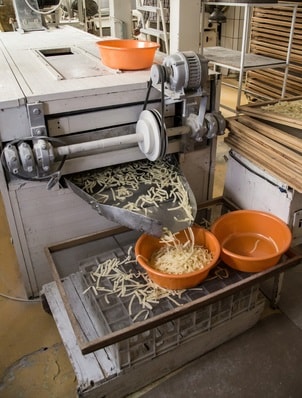We are currently living in a day in age where international food safety standards are at their absolute highest. Programs like the FSMA have put an incredible amount of pressure on food producers to have extremely tight control over their entire supply chain to ensure that the products that they are bringing into the market adhere to the strict cross-contamination prevention guidelines. For food machinery manufacturers, in particular, this means that the equipment that producers use to create their products must be engineered with current regulations and standards in mind. 
When it comes to food machinery, the crux of the engineering must focus on two very important factors: 1) easy disassembly for cleaning and 2) compliance with all appropriate surface finish safety standards. Today, we are going to discuss the latter. Here are the top things that every food machinery manufacturer must know about surface finish standards:
Before we dive deep into the nitty-gritty of food equipment manufacturing standards, let’s take a broader look at what the term surface finish entails.
The surface finish of a piece of machinery speaks particularly to the exact exteriors that food touches while it is being produced. Generally speaking, the most hygienic surface finishes are:
Depending on the objectives of the producer and its facility, these sanitary standards can vary immensely, which means that manufacturers need to be willing and able to adjust the surface finishes of its products to custom-fit their customers’ hygiene needs. A good place for manufacturers to start is by selecting materials that are already verified to fit the appropriate guidelines.
Roughness average, better known as Ra, is the standard in which attending organizations use to assess the safety of the overall surface finish. A surface’s roughness average can be measured using an instrument called a profilometer.
According to information compiled by Food Safety Magazine, 3-A Sanitary Standards dictate that any and all food contact surfaces should not have a Ra that exceeds 0.8µm. Because of this strict guideline, many manufacturers opt for surface finishes such as cold-rolled stainless-steel sheet materials, which usually have Ras of between 0.2µm to 0.5µm.
If customer demand leads to a tricky engineering challenge that defies Ra standards, manufacturers may be able to use approved polishes to lower the average. Further testing can be done using the aforementioned profilometer.

When it comes to achieving a holistic understanding of food machinery manufacturing as it relates to food safety compliance, one of the most important factors to consider is overall “cleanability” of the surfaces. This is because food safety officials and third-party inspectors alike are trained to assess how easily a piece of equipment can be broken down to be cleaned.
It must be done with speed and fluidity which means that all surface finishes must possess the strength to withstand sometimes daily disassembling and reassembling. For manufacturers, the material selected needs to be built to last routine manipulation so that its Ra doesn’t wear down to exceed o.8µm. Before landing on a material, do your due diligence and confirm which compliance laws your producer client is being made to abide by.
Having these precise bylaws in-hand gives the ability to confidently select a material that is flexible enough to uphold its Ra, even when regular disassembly and cleaning is required.
As mentioned above, sometimes it’s necessary for manufacturers to consider applying a surface treatment option in order to achieve a minor Ra. There a couple of ways to do this, depending on the variety of equipment and the food that is intended to be placed on its surface.
In this situation, the manufacturer can apply a polish or varnish that might smooth out the surface even further. This method has the ability to work especially well if, for instance, a maintenance procedure is performed and a surface is showing a Ra that exceeds 0.8µm.
Selecting the correct variety of polish will, naturally, depend on regulations that the producer is forced to adhere to. While many polishes will help fulfill a decreased Ra instantly, not all are approved to be used on surfaces that come into contact with food; so, their makeups must be considered before the application process begins.
With all of this in mind, surface finish should be viewed as just one small component to consider when engineering food machinery. As pressure in the form of changing regulations mounts for producers, manufacturers supplying equipment must become increasingly sensitive to their client bases’ shifting needs.
Our sales engineers are experts in automatic asset tracking, tagging and identification,a nd can answer all your questions. Get in touch now.
Lets Talk ›